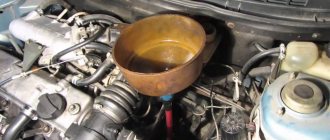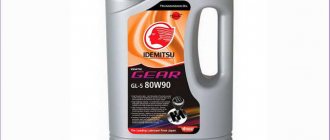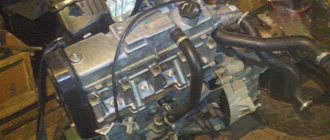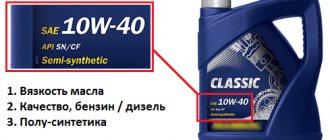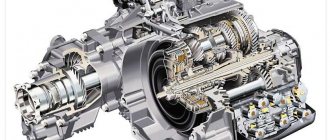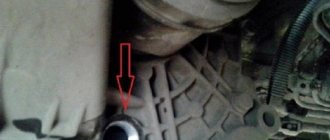Administrator
The oil is changed using a partial change method. A single change requires 4 liters of oil, each subsequent additional partial replacement will require another 4 liters (a procedure with a double change and subsequent removal of the pan will require 8 liters of ATF).
Automatic transmission oil Tiguan (Aisin TF62-SN, aka 09M, aka AQ450 JVZ): Original
ATF 1l G 055 025 A2
Non-original oils
Mobil ATF 3309 (98GX57) ~ 250 rubles for 1 liter. GULF Multi-Vehicle ATF (8717154959437 - 1l; 8717154959444 - 4l) ~ 300 rubles for 1l. RAVENOL ATF T-IV Fluid (4014835733015 – 1l; 4014835733091 – 4l) ~ 300 rubles for 1l. TEXACO MULTI-VEHICLE ATF (5011267833947 – 1l) ~ 300 rubles for 1l. KENDALL VersaTrans ATF (075731020542 or 1042054 -1l) ~ 240 rubles per 1l. Petrocanada DURADRIVE MV SYNTHETIC ATF (055223610390 - 1l) ~ 300r MOTUL Multi ATF (103221 - 1l) ~ 650r Liqui Moly Top Tec ATF 1200 ~ 500r Castrol Transmax Import Multi-Vehicle ATF (079191001431 -1l) ~ 350r Valvoline Maxlife ATF (8710941013299 — 1l) ~ 350rub Febi 29934 (29934 - 1l) ~ 500rub
Should also be suitable (on the advice of Krosh66): Aral 56638 “Getriebeol ATF J” LM Top Tec ATF 1200 TITAN ATF 4400 Comma ASW1L Automatic Transmission Fluid ASW Aisin ATF6004 ATF Wide Range AFW+ Pentosin ATF M Pentosin ATF 1 Toyota 08886-01705
Add. spare parts required for replacement:
09M 321 370 A VAG transmission pan gasket 09M 325 429 VAG oil filter 09D 321 181 B VAG o-ring WHT 000 310 A VAG oil pan plug 09D 321 368 VAG transmission pan magnet (no need to change)
According to the regulations, the manufacturer does not provide for the replacement of ATF, but everyone has long understood why this is done, therefore, by analogy with other cars where replacement is provided, it is recommended to do it once every 40-60 t.km. You can do this, for example, here at Works-Garage or on your own, as shown below.
Device for self-replacement of ATF.
Remove the crankcase protection. Place a bucket or some other container under the automatic transmission drain hole. Use a 5mm hex to unscrew the plug and wait until the oil stops flowing out.
We unscrew the bolts securing the automatic transmission oil pan in a cross pattern and remove it together with the gasket. Because Due to the design of the pan, all the oil does not drain from it through the plug, so when removing it, be careful not to spill oil on yourself.
We clean the pan from oil residues and two magnets from wear products.
We install the oil filter (No. 09M325429), having previously lubricated its gaskets with ATF oil (bolt tightening torque 11 Nm). If the filter was removed and the old one is installed in place, then inspect its gaskets; if they are peeled off or damaged, the filter must be replaced.
We install the pan with the gasket and tighten the bolts that secure it in a cross pattern (the tightening torque of the bolts is 7 Nm). If the gasket needs to be replaced, it is No. 09M321370A.
Screw in the overflow tube (tightening torque 2 Nm).
To fill the oil, I used a piece of brake hose from an Audi and a car syringe. You can use a hose for a plumbing faucet with an M10x1 thread or anything else suitable. Instead of a syringe, you can also use something else, people here suggested options.
Screw a piece of brake hose into the automatic transmission pan, shake the canister of ATF oil and fill the syringe. We connect the syringe hose to the cut brake hose and begin filling the automatic transmission, periodically filling the syringe with a new portion of oil as necessary. In total, fill in 3 liters of ATF. After this, unscrew the piece of brake hose and screw the plug with the old sealing ring into the automatic transmission pan.
We start the engine and switch the automatic transmission selector through all positions, holding it in each position for about 10 seconds. We set the lever in position P, connect the Vag-com, go to block 02, select measuring blocks, enter channel number 006 and look at the ATF temperature. If the ATF temperature is within 35-45°C (if not, you need to wait until it warms up, or turn off the engine and wait until it cools down), then unscrew the automatic transmission oil pan plug. A small amount of oil will flow out of the overflow tube, and if the oil continues to drip, then the level is normal; if not, then the oil must be added.
To do this, with the engine running, again connect the syringe to the filler hole and fill in the oil (according to Elsa, it is recommended to fill in 1 liter at a time). We disconnect the syringe and if the oil does not flow out of the hole, then connect the syringe and continue filling. If oil flows out of the hole, then wait until it flows out to drops (i.e., wait until the stream of leaking oil turns into dripping oil from the hole). After this, we tighten the plug with a new sealing ring (No. 09D321181B), the tightening torque is 27 Nm. I got about 4 liters of oil, as always.
The automatic transmission of modern cars is a high-tech electronically controlled system. The transmission design consists of many parts that operate under severe loads. To avoid unexpected breakdowns and maintain a long service life, you must carry out regular maintenance and use a lubricant approved by the manufacturer.
A little theory: 4-Motion system
In the Volkswagen Tiguan crossover, torque from the engine is transmitted to an automatic gearbox. Next, the transfer case ensures the rotation of the front and rear axles. The movement is transmitted to the front wheels through the front axle differential. At the same time, torque is supplied through the driveshaft to the Haldex all-wheel drive clutch, which drives the final drive and rear axle differential. Depending on the operating mode and driving conditions, the automation distributes torque across the axes, ensuring maximum efficiency.
Volkswagen Tiguan is equipped with a hydromechanical 6-speed automatic transmission with a planetary mechanism, which is characterized by simplicity of design, compactness and low weight. The automatic transmission is equipped with an adjustable torque converter lock-up clutch, as well as electro-hydraulic gear shift drives. The box is equipped with an oil cooler to cool the lubricant while the vehicle is moving.
The rotation of the rear axle wheels is ensured by a Haldex coupling located in the rear final drive housing. Oil pressure on the piston causes compression of the friction discs, and the clutch transmits torque up to 2400 N*m. An electric axial-piston type pump, which is controlled by an electronic controller, is responsible for pumping oil. The working pressure in the hydraulic system of the Haldex coupling is about 29 atmospheres. The system is equipped with a maintenance-free oil filter with a check valve.
Note! If the Haldex clutch pump fails, the oil pressure in the system disappears and the transmission of torque to the rear wheels stops.
Scope of routine maintenance work
In addition to the work performed at each maintenance, there are additional ones (replacing spark plugs, replacing the timing belt, etc.) that are carried out with greater frequency.
List of maintenance work every 15,000 km or 1 year
- Checking seat belts.
- Checking the operation of external light devices, sound signal, light indicators and alarms, interior lighting, trunk lighting, glove compartment (if equipped), sockets and cigarette lighter.
- Check the condition of the brushes and the operation of the windshield wipers and washers.
- Replacing the cabin filter.
- Checking the operation of the hand (parking) brake.
- Check for recall programs and service backlogs.
- Reset the maintenance indicator.
- Visual inspection of brake mechanisms: tightness, condition and degree of wear of brake discs and pads.
- Inspect the windshield for cracks or other damage.
- Lubricating and checking the operation of locking mechanisms: doors, hood and fuel tank hatch.
- Monitoring the level of operating fluids in the hydraulic booster, brake system, and hydraulic clutch mechanism.
- Replacing used engine oil and filter.
- Control inspection of the engine and other components located in the engine compartment.
- Check all brake system hoses.
- Inspection of casings, boots and covers in the front and rear suspensions, CV joints and steering.
- Check the fuel, brake system and brake booster pipes for corrosion and possible damage.
- Checking for leakage of working fluids.
- Monitoring the exhaust system for leaks, corrosion and fastening reliability.
- Visual inspection of springs and stops in the suspension: condition and presence of damage.
- Inspection of steering rod joints: reliability of fastening, condition and protective boots.
List of works performed after 30,000 or 2 years
In addition to the main work, the following operations are performed:
- Monitoring the condition, tread depth and tire pressure (including spare).
- Check and, if necessary, replace the cooling system coolant.
- Replacing the filter element in the fuel filter.
- Replacing the air filter.
- Monitoring the battery charge and maintaining its terminals.
- Replacing spark plugs.
- Visual check of the engine and components in the engine compartment from below, gearbox, transfer case, main gear, moving joint boots for condition and leaks.
List of work to be performed after 45,000 km or 3 years.
- Control of paintwork and possible body corrosion.
- Check and, if necessary, replace brake fluid.
- Changing the oil in the Haldex* PP coupling (for all-wheel drive vehicles).
* - the oil in the clutch is changed every 3 years, regardless of mileage
List of work to be performed after 60,000 km or 4 years.
- Control and adjustment of headlights.
- Checks in motion: operation of the standard and parking brake systems, gear change mechanism, climate control.
- Check the condition, and in case of discrepancy, replace the drive belt of the mounted units.
- Checking the condition and, if necessary, cleaning the outer surfaces of radiators of cooling and air conditioning systems.
- Changing the oil (if available and filter) in gearboxes, hydraulic automatic transmission (for the previous generation), robotic DSG. The manual mechanical one is not mentioned, but in practice the oil in it is changed at the same mileage, according to the principle - you won’t ruin the unit with fresh oil.
- Checking the condition and play of silent blocks in the suspension.
Every 90,000 km or 6 years
Replacing the timing belt.
Download “Maintenance for Tiguan cars” in PDF:
Transmission fluids for Volkswagen Tiguan
For the AISIN 09M automatic transmission, the manufacturer recommends the use of ATF ( Automatic
Transmission Fluid)
standard G 055 025. The lubricant has high fluidity and a characteristic red color.
Those who like to save money on analogues should remember that, unlike standard gear oils 70W-80, 80W-90, in automatic transmissions the lubricating fluid must remain fluid at any temperature up to 120 degrees. Therefore, the SAE viscosity classification does not apply to ATF fluids.
The capacity of the automatic transmission when first filled at the factory is 7 liters. When performing a replacement, about 5 liters of transmission lubricant will be required, since the remaining 2 liters of oil are distributed throughout the lines, cooler cavities and the internal volume of the gearbox and cannot be drained without completely dismantling and disassembling the unit.
The Haldex all-wheel drive clutch is filled with VAG G055 175 A2 mineral gear oil. The volume of the system is 720 ml.
Complete replacement of transmission fluid in automatic transmission
A complete replacement of ATF in an automatic transmission is carried out in the same way as a partial replacement with minor differences. Before starting the engine and driving after filling 4 liters, you need to remove the hose from the radiator return line and lower it into a five-liter bottle.
Changing the oil in an automatic transmission Ford Focus 3
Restart the Volkswagen Tiguan engine and wait until clear fluid comes out of the tube.
- Turn off the engine.
- Unscrew the drain plug again and insert into the other end the hose into which the filling container is screwed.
- Pour in as much lubricant as was poured into the bottle.
- Start the engine. Warm up the car again. You can press the brake pedal and move the shift lever out of Park, shift it to all other settings and back. Thus, the lubricant is evenly distributed throughout all components of the machine.
- Remove the grease filling tube. The waste container should be located under the opening. Because excess lubricant will spill out.
- Wait for excess oil to drain.
- Replace the drain plug and tighten.
For best results, use a high pressure unit, usually found in a workshop. But if the driver is an experienced mechanic and has this device in his garage, then a complete change of lubricant will be successful.
Changing the oil in an automatic transmission
Many manuals indicate that the transmission oil in a Volkswagen Tiguan automatic transmission, filled at the factory, retains its performance characteristics throughout the entire service life of the vehicle. However, in practice, it is recommended to replace the lubricant in the gearbox every 60 thousand kilometers traveled due to the difficult operating conditions of the mechanism.
To change the oil in a Tiguan automatic transmission yourself, you will need the following consumables:
- ATF gear lubricant of appropriate approval;
- oil filter (code 09M 325 429);
- gearbox pan gasket (code 09M 321 370A);
- sealing ring for the drain plug (code 09D 321 181B);
- container for draining oil;
- rags.
To carry out the work, you will also need a device for pumping transmission fluid.
To successfully change the oil in the Tiguan automatic transmission, it must be warm. To do this, you need to drive for at least an hour in various modes. After the lubricant has warmed up, the car is installed on an inspection hole, overpass or hung on a lift.
To access the gearbox, the engine protection and gearbox mudguard are removed. The box tray and adjacent surfaces are cleaned of dust and dirt. To drain the old transmission lubricant, you need to unscrew the drain plug with a No. 5 hex wrench.
Warning! Transmission oil flows out of the gearbox opening in a spiral stream, so it is recommended to use a suitable sized funnel to collect the oil to avoid spilling the fluid and contaminating clothing and the work area.
After about one liter of oil has drained, you need to unscrew the overflow tube using a hexagon to ensure further flow of lubricant.
When the leakage of transmission lubricant stops (the total volume of drained fluid will be about 4 liters), the drain plug is put in place, and the bolts securing the automatic transmission pan are unscrewed with a 10mm wrench.
The remaining lubricant is drained from the dismantled pan, the inner surface is thoroughly wiped dry with a rag, and metal particles resulting from wear of the box parts are removed from the magnets. Then the oil filter with a protective mesh is disconnected from the valve body.
Information! In most cases, automatic transmission breakdowns are caused not by deterioration of the properties of the transmission lubricant, but by the leaching of solid metal particles into the gearbox mechanism that were not removed from the pan magnets in time.
A new filter and pan with a fresh gasket are installed in their original place. Before installation, it is recommended to pre-coat the oil filter seals and pan gasket with transmission oil.
How to change the oil in a Volkswagen Tiguan automatic transmission
Changing the Tiguan 2 0 automatic transmission oil can be done after all the preparatory work, selection of rags, tools, and transmission fluid. It is recommended to warm up the car first.
The automatic transmission must be accessed from below
Complete oil change in a Volkswagen Tiguan box
A complete oil change in a Tiguan 1 4 gearbox is a complex procedure; it is best done at a car service center, but you can do it on your own. Oil – Top Tec 1700 from Liqui Moly or another.
Full-flow change allows you to wash the automatic transmission using special compounds. Such flushing eliminates contamination, restores impaired gear shifting functions, the operation of the hydraulic transformer locking system, the functioning of the solenoid unit, and can negatively affect the condition of the automatic transmission.
The procedure is expensive and lengthy. For example, to displace old ATF and flushing composition, you need to pump double or at least one and a half volumes of fresh fluid through the box. Some more volume will be lost when replacing the automatic transmission filter. The presence of a special installation for accurate dosage and automatic recording of the volume of drained lubricant is mandatory.
The fastening bolts must be unscrewed carefully
Procedure for changing the oil in a VW Tiguan automatic transmission:
- Checking the ATF level.
- Connecting the flushing unit to the hydraulic circuit. It is most convenient to use cooling hoses for these purposes. Many models have the option of connecting without using fittings; the connection must be made using clamps. It is important to find the cooling radiator correctly - it is located inside the engine system. If you provide access to the fittings, you will be able to disconnect the supply tubes and then you can reconnect them.
- Start the engine. The installation itself will determine the direction of circulation of the working fluid and set the optimal pressure inside the system. If it does not develop, the device considers it as a broken box and a replacement cannot be made.
- Fill in the flush - it will remove all typical contaminants and restore normal operation of the valves and hydraulic unit. Pouring is done into heated oil, since the additives are active at high temperatures. Let the automatic transmission run in park or neutral for 5-6 minutes. In this case, the valves will work to drain and will be cleaned as actively as possible. For another 4-5 minutes, you can switch modes to start circulation washing processes through different channels. The car will remain in place, held by the parking brake.
Development of a Tiguan automatic transmission after changing the lubricant
To evenly distribute the lubricating fluid throughout the entire volume of the box, it is necessary to ensure the operation of the automatic transmission in all modes for several minutes. After this procedure, you should check the ATF level.
Checking the lubricant level is carried out using a laptop with pre-installed software, for example, VCDS or VAG K.
On the device connected via the diagnostic connector, the menu is activated: “Automatic transmission” - “Measured values” - “Group 06”.
The initial conditions are set according to the manual:
- ATF transmission oil temperature no more than 30 degrees;
- the machine is standing on a flat horizontal surface;
- The gearbox selector is in the “Parking” position.
With the car running, when the “ATF temperature” indicator reaches a value ranging from 35 to 45 degrees, the automatic transmission oil level check plug is unscrewed. If there is a sufficient level of lubricant, about 300 grams of oil will drain from the bypass tube. After this, the control hole is tightened with a plug with a new sealing ring. If transmission lubricant does not flow out of the control hole, then the gearbox needs to be topped up with oil.
After completion of the operation, the surfaces of the parts are cleaned of oil residues, and the connections are checked for leaks.
You can get a visual representation of the process of changing the oil in a Volkswagen Tiguan automatic transmission from the following video:
How often should the Tiguan transmission oil be changed?
It is recommended to change the automatic transmission oil after 60,000 kilometers. The developer of the box, Aisin, recommends changing the ATF after every 20,000 kilometers. (But recommended for countries with hot climates). Do not allow the oil to heat above 105 o C. Next:
- At 115 o C, transmission fluid turns into varnish;
- At 126 o C the seals harden;
- At 146 o C the clutches slip;
- At 157 o C, seals and couplings burn out, and soot forms in the liquid.
The main reason for failure of the 09G automatic transmission is overheating in 90% of cases.
In conditions of bad roads in Russia, strong variable loads on the transmission, shocks and slippage are possible. This also shortens the service life of the automatic transmission.
Changing the oil in the Haldex all-wheel drive clutch
According to VAG recommendations for the Haldex clutch, oil changes should be carried out in the range of 40,000-60,000 kilometers traveled, depending on the frequency and intensity of use of the all-wheel drive. For cars with low annual mileage, it is recommended to change the grease in the clutch every 12 months.
4th generation Haldex
To independently change the transmission oil in the Volkswagen Tiguan all-wheel drive clutch, you will need the following tools and materials:
- container for draining liquid;
- set of wrenches;
- pliers;
- a medical syringe for 100 cc and a flexible tube of suitable diameter;
- new oil for the Haldex coupling;
- oil purification filter 31325173;
- rags;
- gloves and safety glasses.
Work is carried out on an overpass, inspection pit or on a car lift. To carry out an oil change, the machine must be installed strictly horizontally.
To preheat the old oil to facilitate the draining process, you should operate the car in all-wheel drive mode. Before removing the waste fluid from the coupling, you need to unscrew the two fixing bolts, remove the fine filter cover, use pliers to pull out the plastic gasket and dismantle the filter element.
Advice! You can briefly start and immediately stop the engine so that the oil pressure forces the filter and gasket out of its seat.
Then the clutch drain plug is turned out and the transmission fluid is drained by gravity into a suitable container.
After the procedure is completed, the plug is screwed back into the Haldex coupling body, and a new filter, pre-lubricated with oil, is installed in the seat.
You also need to make sure there is no damage to the O-rings that are located on the plastic gasket. Failed seals are replaced with new ones to prevent oil leakage. The assembled gasket is inserted into the coupling.
New oil is poured into the Haldex coupling using a syringe. To do this, instead of a needle, a flexible tube is put on, which is inserted into the filler hole. The procedure is carried out until grease begins to flow out of the hole. After a sufficient amount of transmission oil has been filled in, the filler plug is screwed in and the clutch housing is wiped dry with a rag.
Then a test drive is made, after which you should turn off the engine and make sure that there are no leaks from under the Haldex coupling plugs. After 10-15 minutes, you need to unscrew the filler plug to check the lubricant level. If liquid flows out, then the level is sufficient. If necessary, transmission lubricant is added to Haldex. After checking, the plug is installed in place, oil spills are removed with a rag. This completes the procedure.
The procedure for changing the oil in the Haldex VW Tiguan clutch can be seen in the following video:
5th generation Haldex
The sequence of work for changing the oil in the fifth generation Haldex is similar to that described above, with one exception. As a result of the current trend towards reducing the size and weight of automotive units, the control solenoid valve has been removed from the all-wheel drive clutch design. Accordingly, Haldex 5 does not have a fine oil filter. As a result, wear debris (metal dust and swarf) accumulates in the oil circulating through the hydraulic system and is likely to lead to serious failure. Therefore, for a greater guarantee for the new clutch model, the interval between transmission lubricant changes should be reduced by several thousand kilometers.
WV Tiguan 2.0 TDI (140hp). and in the HALDEX coupling. Have questions. (Alexander)
Good day, Alexander, we will briefly tell you what gear oil (TM) you need and how to change it.
[Hide]
Complete replacement
All automatic transmissions have a torque converter. A simple replacement does not make it possible to change the transmission fluid completely. Almost the same amount will remain in the torque converter and the box itself. To change the rest you need to:
- Drive approximately 300 km and repeat the operation, then do the same again;
- Contact a service station that has the appropriate equipment - a high-pressure unit.
Read also Oil for Volkswagen cars: features of selection and replacement
The operation of the high pressure unit is based on the principle of substitution. The device is equipped with transparent tubes. The operating procedure is as follows:
- A gap is created between the torque converter and the automatic transmission;
- A unit filled with fresh oil is switched into the gap;
- The engine starts and the unit starts up;
- ATF is circulated through the unit with simultaneous cleaning in a special filter of the unit until the color of the liquid becomes like fresh.
The operating time of the unit is approximately one hour. ATF quality control must be carried out systematically:
- If the oil is clean, transparent, and has a reddish color, this is normal;
- If it is cloudy or gray, you should order spare parts and consumables;
- If it is black and has a burning smell, you should start replacing it at home or at a service station.
You should not be afraid to go to the service station. Allegedly, someone I know, after a complete oil change at a service station, the automatic transmission broke down. It’s just that a person drove his car until the material covering the friction discs collapsed and passed into the transmission fluid. With such oil, the discs do not slip, but other automatic transmission components are destroyed without appropriate lubrication and cooling. After flushing and replacing the ATF, the friction discs in the box begin to slip and the box fails.
Replacing the TM in an automatic transmission Tiguan
Service books usually write that the service life of the lubricating fluid in the transmission system is equal to the service life of the vehicle as a whole, so there is no need to change consumables. However, when replacing the TM with a new one, you help increase the service life of the gearbox.
If you decide to undertake this, you must understand that the procedure as a whole is quite labor-intensive and not easy, so prepare everything that may be useful to you, namely:
- original TM (standard G 055 025);
- new gasket for the transmission pan;
- transmission system filter element (preferably replaced as a set);
- drain hole rubber;
- large syringe (construction or veterinary) with a hose.
Before starting the process, you should warm up the car so that the oil warms up well. It may take about an hour of driving with all transmission modes activated for the TM to travel through the entire system.
Then drive the car onto the overpass and wait a few minutes for the TM to cool down:
- Using a 5mm hexagon, you need to unscrew the drain cap, this will release the first portion of lubricant.
- Using the same hexagon, you need to unscrew the filler plug and also drain the waste material (about 4 liters should come out).
- Then you need to unscrew the screws of the transmission pan and remove it. Be careful when doing this, because after removing it, the TM will drip from everywhere.
- After this, you need to clean the tray and also pay attention to the magnets.
- Next, using wrenches, unscrew the screws that hold the oil filter, and then remove the element itself. If necessary, you need to change it, but we recommend doing it anyway.
- Change the pan gasket and install it in place, after lubricating the rubber with oil. After installing the pan, install the filler cap.
- Then we proceed to the most difficult aspects - the new TM must be poured into the box using a syringe with a tube. After this, the engine needs to be started and each gearbox operating mode must be turned on in turn. You need to stop in each mode for 2-3 minutes so that the TM can move through the system.
- After this, the level is checked and consumable fluid is added if necessary. Screw on the cap and ride to your health.
Do-it-yourself partial oil change in a Volkswagen Tiguan automatic transmission
For a partial replacement, 4 liters of ATF will be required.
In addition to spare parts, we will need:
- Keys;
- Screwdrivers;
- Hexagons;
- Heads;
- Torque wrench with a range of 5-25 Nm;
- Lint-free rags;
- Container for drainage;
- Hose;
- Refill capacity.
When replacing transmission fluid, it is imperative to change the gasket, filters, and bolts.
A crushed gasket will leak. Dirty filters will be washed away by clean oil and waste will quickly spoil the liquid. Corroded bolts will not hold the pallet well.
Draining old oil
- Warm up the ATF to 35 o C, or if there is no diagnostic equipment, then let it run for 10 minutes. After squeezing the clutch, move the selector through all positions;
- Unscrew the drain plug and pour oil into a measuring container (you need to know how much has drained);
- Using a 5 mm hexagon, unscrew the overflow tube and drain the remainder;
- Unscrew the pallet mounting bolts and remove the pallet;
- Drain the liquid from the pan.
Washing the tray and removing chips
The procedure is as follows:
- Carefully inspect the magnets for the presence of chips and remove them;
- Remove the rubber gasket;
- Clean with WD-40 and install a new gasket.
Replacing the filter
The filter must be replaced. Washing the old one will not work. With further use, the new oil will wash away the residue on the filter, which will ruin the ATF.
- Install a new filter in the automatic transmission;
- Install the pan, degreasing the contact points;
- Tighten the bolts with a force of 8 Nm.
Filling with new oil
The replacement sequence is as follows:
- Replace the overflow glass;
- Pour ATF from the sales container into a filling container;
- Secure the hose to the drain hole;
- Pump in approximately 4 liters of ATF under pressure;
- Start the car and warm up to 40 o C;
- Remove the hose and allow excess oil to drain;
- Tighten the plug.
Video “Nuances of replacing TM in automatic transmission”
The nuances of replacing fluid on an automatic transmission are shown in the video.
Under severe operating conditions (overheating, standing in traffic jams, long-term driving at low speeds, frequent trips over short distances, etc.), the automatic transmission oil becomes contaminated, loses its properties and contributes to wear of the mechanism. Therefore, periodically replacing the Volkswagen Tiguan “transmission” helps:
- get rid of gearbox vibration when stopping,
- soften shocks when changing gears,
- improve the clarity of the box operation.
Spare parts
On the conveyor, ATF oil marked G055025A2 is poured into the automatic transmission. It is not recommended to mix it with other liquids, so in case of incomplete (partial) replacement there is no alternative to the original. With a complete update, you can choose either the original “transmission” or any other that meets VAG approval (Mobil, RAVENOL, etc.). The total volume of boxes 09G/09M is 7 liters.
Depending on the selected update method, you may additionally need:
- filter (original number 09G325429A),
- automatic transmission pan gasket (09M321370A),
- pair of magnets (09D321368),
- plug (WHT000310A) with o-ring (09D321181B).
Operating materials
This issue is discussed in more detail in another material, but here we will dwell on the key points.
For gasoline engines of the latest generation Tiguans, the original VAG Special C
0W-30 oil is used. A replacement is possible, but the alternative must have a VW 502.00
and it is highly desirable to have the same viscosity index. Given the narrow oil channels, more viscous oil may not reach the friction pairs in sufficient quantity.
| Unit | Operating material | Filling volume, l |
| Engine 1.4 TSI | VAG Special C 0W-30 | 3,8 |
| Engine 2.0 TSI | VAG Special C 0W-30 | 5,7 |
| checkpoint | G 052 18 2A2 | DSG6 - 6.9 DSG7 - 7.6 Mechanics - 2.3 |
| Transfer case / Gearbox | G 052 145 | 0,9 0,95 |
In the Haldex coupling (all-wheel drive connection), only original VAG G 060 175 A2 oil can be used; replacement is not permitted. Volume - 0.85 l.
Work order
There are several ways to change the contents of an automatic transmission:
- the simplest is through a drain hole closed with a screw plug (this allows only about 1 liter of the total volume to be drained, the rest of the liquid remains in the pan and the cooling radiator),
- partial - with removing and washing the pan, as well as replacing the filter (this method allows you to change about 60% of the total volume),
- the most complex and effective - with the connection of special equipment into the main line (allows you to completely renew the oil).
The first method is usually used by amateurs who are not familiar with the design of the Tiguan. Due to the low amount of fresh liquid, this method will not have any effect.
Each of the remaining methods requires appropriate equipment and has its own advantages, which is why our specialists prefer them.
A very important stage of repair, on which the smooth operation of the box depends, is adjusting the level of the filled oil, which is carried out at a temperature of 40°C. Most accurately, the heating of “ATP” is controlled by a diagnostic tester.
Contact our network of car services if you want to be sure that all operations to change the “transmission” have been completed.
It is believed that the oil in the gearbox is changed only when the automatic transmission itself is changed, however, the use of new lubricant can extend the service life of the mechanism. This article will discuss how to change the oil in an automatic transmission Tiguan 2 liter engine capacity.
How to choose oil
ATF recommends using strictly those consumables and spare parts that are specified in the “Operating Instructions” of the vehicle. The automatic transmission for an engine using gasoline or diesel is the same.
Original
It is recommended to change the oil in the Tiguan automatic transmission using the ATF G055025A2 brand from VAG. This liquid has all the additives necessary for normal operation. It has a stable viscosity and quickly and efficiently lubricates all rubbing parts of the gearbox.
- Automatic transmission filter 09M 325 429 (1 piece);
- Automatic transmission pan gasket 09M 321 370 A (1 piece);
- O-ring 09D 321 181 B (1 piece);
- Pan drain plug WHT 000 310 A (1 piece);
- Pan fastening bolt WHT 000 309 (9 pieces).
Analogs
As analogues, it is allowed to use Mobil ATF 3309
- Automatic transmission filter MEYLE 100 325 0010 (1 piece);
- Automatic transmission gasket MEYLE 100 139 0003 (1 piece).
What will you need?
In order to carry out this difficult procedure yourself you will need:
- Transmission oil - the automatic Tiguan is filled with G055025A2 lubricant, it is better to buy oil in a five-liter canister;
- Automatic transmission filter - the filter is changed every 5 thousand km, and with any oil change;
- Gasket for the pallet - the sealing rubber gasket must be new; pressed rubber will not be able to sufficiently seal the gaps;
- Magnets - two pieces;
- Plug for the pallet - it should be rubber and fit tightly into the hole.
Preparing for an oil change
Before starting the procedure, you should warm up the car at idle until the engine is running. But for greater reliability, it is better to travel with all gears switched so that the lubricant warms up in all compartments of the gearbox.
It is important to know that timely replacement of the lubricant in the automatic transmission is necessary due to the fact that the magnet that pulls out the chips during operation of the gearbox has a limited resource.
You can drive the car onto a lift or overpass and wait for the lubricant to cool down to a temperature acceptable for replacement.
Transmission oil change interval
The manufacturer indicated in the manual that it is recommended to change the oil in the Tiguan automatic transmission every 100 thousand km. Experienced car owners and mechanics at large service stations recommend doing this every 60 thousand kilometers. If the car is operated in extreme conditions and travels more than a thousand km per day, it is recommended to partially replace the lubricant once every 20,000 km.
The Aisinovskaya 09M gearbox is installed on the Volkswagen Tiguan. Despite the fact that it is made to be unpretentious and hardy, it needs to be looked after. Every 10 thousand kilometers, the car owner must check the lubricant level in the automatic transmission.
Attention! The Tiguan's automatic transmission is a joint development between German (VW) and Japanese (Aisin) manufacturers. The first modifications of the car were sold with automatic transmission, manual transmission and robotic gearbox. After restyling the Tiguan, the company abandoned the standard automatic transmission. Only manual gearbox and DSG were used.
A robotic transmission requires much less oil than an automatic transmission. But in terms of reliability, the first one is still inferior to a car. Therefore, despite the manufacturers’ assurances of the car’s reliability for those who like quick starts, drives and other movements on the car that destroy it, the Tiguan will last longer in the hands of a calm driver.
Do-it-yourself complete and partial oil change in the RENAULT Duster automatic transmission
Step-by-step instruction
Step-by-step instructions for replacing lubricant in a Tiguan automatic transmission include the following:
- The first part of the oil must be drained using a hexagon, do not forget to place a newspaper or rag under the pan; Important to remember! Before draining, you should wait about 10-15 minutes so as not to get burned by the lubricant, although it does not reach the same temperature as motor fluid, it is still better not to risk it.
- The second and main portion of transmission oil should be drained through the filler hole, the plug from which should also be unscrewed using a No. 5 hexagon. In total, about 4 liters of waste should spill out; Note! The condition of the transmission lubricant can indicate problems with the gearbox; if a large amount of metal shavings is observed, it means that the operation of the transmission has been disrupted;
- Afterwards, you should loosen all the bolts that hold the pallet in place; when they are all torn off, you will need the help of a partner. One person should hold the tray while the other person should completely remove the screws. Be careful, because it is quite difficult to hold the removed pan without allowing the waste to overflow;
- The last thing to dismantle is the oil filter; for this, the screws securing it are also loosened using wrenches, and it is removed from its seat without any problems;
- Install the new filter and securely fix it with the bolts, without overtightening them;
- After draining the waste from the pallet, wipe it with a rag and proceed with installation. Remove the old gasket from the joint; if it is stuck, use a screwdriver. If necessary, clean the contact area of the rubber gasket with sandpaper and wipe it, removing excess debris;
- Lubricate the new rubber gasket with oil on both sides and place it on the pallet;
- Screw it into place so as not to squeeze the rubber gasket;
- Installation of the filler plug is done last before adding clean oil;
- Using a medical syringe and a rubber tube (can be replaced with a nylon tube from a dropper system), begin pouring new transmission oil into the gearbox. This is the most labor-intensive and time-consuming procedure;
- When the oil is poured, you should start running it throughout the automatic transmission. To do this, with the car raised, let the engine run for 2-3 minutes in each mode. During this time, the oil will pass through the entire system, and the next operation can begin;
- After checking the oil level, you should decide whether topping up is necessary or whether it meets the required standards.
Practical advice on choosing oil in a VW Tiguan automatic transmission
Before changing the oil in a Tiguan automatic transmission, the car owner must figure out what type of original lubricant is suitable for it. And also discover oil analogues if you don’t find the original on the market.
Using lubricants from Chinese manufacturers and oils intended for other gearboxes will render the Tiguan machine unusable before the warranty period expires. Petrol vehicles (TSI) and diesel vehicles (TDI) are equally affected.
Original oil
Experts recommend using original VAG lubricant. This is ATF G055025A2 in a Volkswagen Tiguan box. The manufacturer filled it with additives that:
- reduce the temperature when operating the Tiguan automatic transmission;
- they are able to provide high-quality circulation for transmissions with a certain slip lock.
- increase the service life of rubbing parts;
Tiguan oil has a stable viscosity. Thanks to this, it instantly gets into hard-to-reach areas of the automatic transmission and lubricates all the main and driven parts of the machine.
Analogs
Analogs of Volkswagen Tiguan automatic transmission fluid include the following lubricant:
- Mobil ATF 3309.
It is not recommended to pour the remaining ATF into this type of car. Since its durability depends on the quality of the oil in the Tiguan box.
